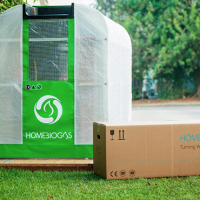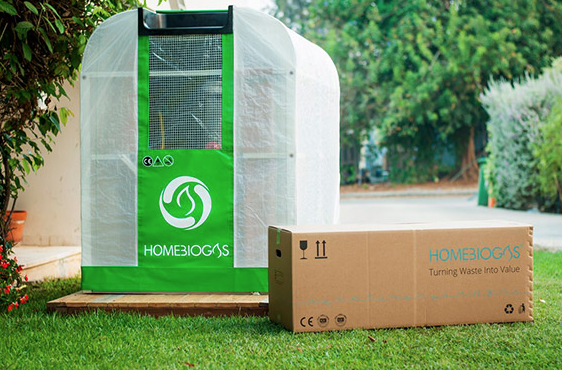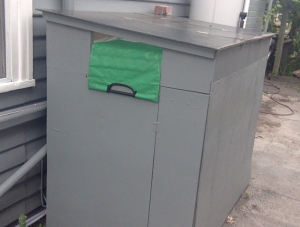Home Biogas Review: Independent Assessment from Australia
Biogas is a renewable energy source with net-zero emissions. In an age of worrying climate change and looming fossil energy decline, wouldn’t it be great if we could produce biogas at our homes and burn it as a cooking fuel?
Well, it turns out you can. That’s what I’ve been doing in recent months and it’s helped enable our household to completely disconnect from conventional (fossil) gas and reduce our consumption of electricity. Today I’d like to tell you about my experience with home biogas production, as part of my ongoing research into sustainable energy practices.
First, what is biogas?
Biogas is produced when organic matter biodegrades under anaerobic conditions (i.e. in the absence of oxygen). This process produces a mixture of gases – primarily methane, some carbon dioxide, and tiny portions of other gases, such as hydrogen sulphide.
When the biogas is filtered to remove the hydrogen sulphide, the resultant gas mixture can be used as an energy source, since the dominant methane component makes biogas combustible.
Biogas can be used for cooking, heating water or space, and lighting. When compressed it can be used as fuel for vehicles. On a commercial scale it can be used to produce electricity or even refined and fed into the gas grid.
The types of organic matter used to produce biogas include food waste, animal manure, agricultural by-product, and some commercial systems use sewerage to produce and capture biogas.
As noted, the primary benefit of biogas is that it is a renewable energy source with net-zero emissions. Biogas has net-zero emissions as a fuel because the carbon that is released into the atmosphere is no more than what was drawn down from the atmosphere when the organic matter (e.g. the food) was grown.
There are other significant benefits as well. Usually the organic matter used in biogas digesters is considered a waste product. But that waste product – for example, food waste – becomes green energy when turned into biogas, reducing waste sent to landfill.
Furthermore, biogas systems themselves produce a nutrient-rich sludge that can be watered down into a fertilizer for your garden or farm. All this can develop increased energy independence, close nutrient loops, and build resilience, while also saving money.
How my household came to produce home biogas?
In 2015 I came across a crowdfunding campaign by a group of scientists and entrepreneurs who were seeking funding to make ‘home biogas’ units available for households. I thought to myself: that sounds amazing! But at that stage I didn’t act on this instinct. Two years later, I rediscovered this group of biogas pioneers and saw that their home biogas units were now available. I did a lot of research and then purchased one of their units. Below I offer an independent review of this product based on my personal experience. Please note I have no affiliation, commercial or otherwise, with this company.
Cost, size, functionality, and performance
The unit I purchased cost just over AU$1000, including delivery. The company is currently crowd funding for their new model 2.0, which looks considerably cheaper (US$495 plus delivery) and based on a refined design. I offer a review of the original model, but in essence version 2.0 remains the same for the purposes of this review.
The product arrived within a couple of weeks. I invited a friend over to construct the unit. The instructions were perfectly clear and it took us about four or five leisurely hours to construct. While it could be constructed by one person, I’d certainly recommend having a second person to assist. Version 2.0 looks even simpler to construct.
The unit is well made, sturdy, and robust. While one element in the system arrived in a faulty condition, the company promptly replaced the element and assured me that such faults were extremely rare. I have only good things to say about the company’s customer service: prompt, knowledgeable, and full of integrity. My unit is now functioning perfectly.
The main features of the home biogas unit are a 650L digester bag that you fill with water. Above that is the bag that collects the gas. Upon the gas bag sit 80kgs of sand bags, which provide the pressure for your gas supply. (Sand isn’t included). There is an inlet basin and tube, connected to the digester bag, in which you place your food waste, and an outlet pipe, where the fertiliser comes out.
The unit I have is 100cm deep; 127 cm high; and 165cm long. So it’s a decent sized unit, but not unmanageable. This product won’t be for people living in apartments with no land, but it may well suit many suburbanites and farmers.
When the unit is constructed, you fill the digester with water. Then begins the ‘activation’ phase, where you need to activate the bacteria required for biogas production. This involves putting 100kg of fresh animal manure (cow, horse, or sheep manure, but not chicken manure I’m told) into the system and ideally having temperatures around 35 degrees C.
Fortunately, it’s summer in Melbourne, so the temperatures are very warm, but just to be sure, I used a 300W aquarium heater (powered by our solar panels) to ensure the digester temperature remained warm enough in this activation phase. Depending on where in the world you are, the aquarium heater may not be required. After the activation phase, the digester unit still functions at 20 degree C or above, so many places will not need the heater. I have built a small green house around my unit (see below), which keeps the unit sufficiently warm, even at night, although a green house may not be necessary.
After the activation phase is complete and the gas bag is full (this phase took three weeks), you can start feeding the unit food waste. I’ve been feeding the unit exactly 2kg of food waste per day, and so far our household has had more gas than we’ve needed to cook on. Although there are ways to adapt existing gas stoves, we purchased two separate biogas cookers (since our stove is electric). In terms of performance, it feels like you’re cooking on conventional fossil gas, but its biogas! Often we use it twice a day – morning and night. I’ve even purchased a biogas hot water unit because I now have a strange problem: more renewable energy than I can use. I will continue to monitor inputs and outputs. These are preliminary but very promising results.
My small household doesn’t produce 2kg of food waste on its own, so two of my neighbours kindly donate their food waste. When necessary, I cycle to my local vegetable market, enthusiastically jump into their large food waste bin, and take what I need. There is essentially an unlimited supply of food waste in our society, so if I decide I need more biogas, I can put in more food waste (up to 6kg per day). Everyone seems happy that this waste stream is being turned into green energy. The planet is happy too.
I have to say that I am utterly blown away by this technology. I’m cooking on biogas produced from food waste, and saving money! Based on similar technology and systems, home biogas is produced in developing parts of the world – for example, there are 27 million similar units in China and 4 million similar units in India. But this unit I have seems to be one of the first commercially available units designed for use in the developed regions of the world too.
Some more information on how it works is available here.
Any criticisms, concerns, or cautions?
At first I was worried that this system might be smelly or attract flies. Fortunately, I’m happy to advise that there is very little smell and no flies. When you feed the system, you do get a whiff of biodegrading food, but this is momentary. The system is well designed so that smell is contained and flies don’t have access. Similarly, when the fertiliser comes out the outlet tube there is a very short whiff of smell but that quickly dissipates. In short, smell is not something I feel you need to worry about.
Does it take long to manage the system? Not at all. I invest about 5 mins each day feeding the system. In return I get all the renewable cooking gas I need. This strikes me as a very good exchange. Once a week I bike to the local food market to pick up food waste, which takes me less than 20 mins.
Is the system safe? I wouldn’t be using the system if I didn’t think it was safe. Indeed, the reason I am using the system is because I know that fossil fuels are very unsafe. Furthermore, the system has gone through ten years of engineering design, scientific testing, and refinement. Most importantly, the gas is filtered to remove the hydrogen sulphide. It is also low-pressure gas supply, which is a safety feature. This unit also comes with safety certificates and this unit has been used and supported by the United Nations. From their website:
– HomeBiogas was tested by and received the European Community CE stamp of approval for safety.
– HomeBiogas received two ISO certifications: certification 9000 for Quality Management and 14000 for Environmental Management.
– Lastly, HomeBiogas was tested by and approved for safety and health by the Israeli Ministry of Environmental Protection and the Ministry of Energy Infrastructure.
Each specific jurisdiction will have its own council or state regulations so you may want to do your own research in that regard. It is unfortunate that there is no Australian Home Biogas Act (yet?) that clearly governs the use of this technology, but perhaps this will come with time as this technology expands and develops. Almost every Australian household already stores gas in their backyard for cooking – the Aussie BBQ is everywhere. One day perhaps every household will have a home biogas system.
I can only see a bright future for home biogas. I will continue my careful scientific monitoring of this system and report back in due course.
You can learn more about the system here – including a video and FAQs. There is also a longer video available here.







[…] Alexander has an excellent review of the original Home Biogas unit over at Simplicity Collective. Check it […]
Shared to Imagine Melton Zero Waste on Facebook. Thank you for sharing this information and your experiences.
https://www.facebook.com/zerowastemelton/
Latest post from Karen Ellis…Tinkering Travellers
Great article, thank you! Will you be posting it on the Facebook page as I would like to share it, many thanks
[…] Alexander has an excellent review of the original Home Biogas unit over at Simplicity Collective. Check it […]
Thank you for this article. Inspiring. Do you know of a septic unit that is geared to produce bio gas. I can’t see my wife diligently saving food waist and feeding the digester but puting them down the sink via a sinkerator would work. Also the obvious benifit of usi g other waist.
Thanks again
Thanks Alexamder. Have you tried using it for heating? That would be our greatest gas useage.
Hi Maddy, apparently it can be used for heating but I haven’t looked into that yet. My sense is I’d sooner use it to heat water than space, but cooking probably best start.
What happens to the system if it is not ‘fed’ or gas released daily, ie you go away on holiday for 1-2 weeks?
It stops producing gas when there is no waste being put into it – not immediately though (although I haven’t tested how long it takes to stop producing since I’ve been feeding mine daily). If you have a full gas bag and more gas is produced, it burps the gas out so the bag doesn’t overfill. You want to avoid this, since the gas is methane and that’s what you don’t want in the atmosphere. If you are going away, therefore, it might be worth stopping putting food in a few days or a week before leaving to ensure you don’t have the bag burp surplus gas. When you return, start putting waste in again and the gas will start producing again.
Hi there, thanks for this review. I am considering one of the second generation home biogas systems for my offgrid home in far North Queensland. I believe you can use manure in the syestem? We have pigs, goats, chickens and ducks but I also wondered if it is possible to use dog faeces in the units? We have two massive dogs and their waste is always a problem. You also mention in the article biogas stoves and water heater do you have links for these it would be great to get some recommendations! Thanks in advance.
Yes, you can use manure in the system. You might want to check with the manufacturers, but my understanding is that goat and pig manure would be fine, but they advise against chicken manure – apparently too high in ammonia and affects the ph of the system. Not sure about duck. They also say that cat and dog manure fine too. I don’t have links to the stoves and heaters. They manufactures will advise. Their customer service is excellent.
Hi Samuel
Have you had to empty it at any time, like does sludge build up over time and need to be flushed or cleaned out like the bio cycle septic tank does every few years.
Thanks for your review
I haven’t had to empty it yet but the manufacturers say it should be partially drained once every 3-5 years I think. There is a special outlet tube to drain the sludge that accumulates at the bottom over time. As I say, I haven’t done it yet but imagine it would take an hour or so, so a small time investment and very infrequent.
hi. if using the new toilet system with the 2.0 can the liquid fertilizer be used on the fruit trees and the veggie patch?
Hi Samuel, I enjoyed the review. I was wondering, did you continue to use the digester during winter and if so how much cooking time did you get on average per day? And did you need to heat to digester during winter? Thanks.
Yes, I continued to use the digester all winter. No heating, other than the greenhouse (which probably wasn’t hugely influential). I stopped gathering data but very little noticeable change in production. Probably a minor slow down but enough to cook on all winter with very few exceptions. I did measure the temperature of the digester and it did get down to 13degrees C. At this level I’m surprised it kept working so well, but as a matter of fact it did work well all winter. The Home Biogas people suggest that it needs heating when it drops below 20 degrees. I guess more research is needed to be confident where the temperature threshold sits and to what effect.
I haven’t looked into their new toilet system but my strong suspicion is no, the fertiliser from that toilet system should not be used on fruit trees and vege garden. It would not have had enough time to safely biodegrade, so it should be treated as black water. For more information, I’d approach the manufacturers.
Can I ask where you can purchase the cooktops. I see you can convert normal lpg but my preference is to not have to convert
Hi Samuel, very interesting product and good review. I have 2 questions; 1) the food waste you put in, do you have to filter them carefully to ensure there are no plastics placed accidentally or even like the small fruit label stickers. 2) The fertilizers that come out, can they be used straightaway on plants or trees or they need to be dried first?
Hi Samuel
I have the 2.0 Home Biogas unit up in Brisbane & its working really well. Have you managed to make any headway on getting approvals in Victoria? Hope if governments do allow the great opportunity from these units can be taken up by many more people without going “rogue”. Emails & phone conversations I have had with Qld Gov bureaucrats have been a dead end to date. Was thinking approaching ministers for environment & energy might be my next point to try. Enjoyed the Degrowth in the Suburbs video.
Dear Samuel,
Did you ever get the biogas hotwater system going?
Thanks,
Lionel Chan (Bhante Jason`s brother)
Hi Samuel,
How’s your system working in 2023? Has the bag leaked at all? Any update would be appreciated. Thanks.
Still working perfectly! More than 5 years in. Home Biogas have since updated their model to 2.0 which apparently is even better / more efficient / etc.
I made a video recently on home biogas and my unit, see here: https://www.youtube.com/watch?v=S0rd65kvlkw
Yes, got the hot water system going. Generally we use the gas for cooking and we only use the hot water system when there is surplus gas, which isn’t that often. But as a test case, it was very successful.
I was just watching an interview with Bhante Jason last night! With the Guru Viking. (I’m writing in Feb 2023).